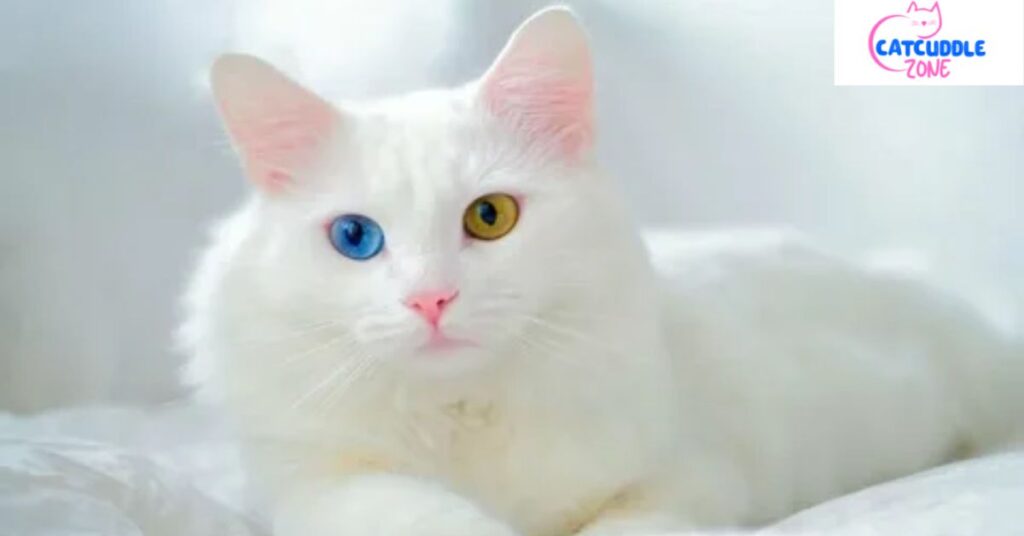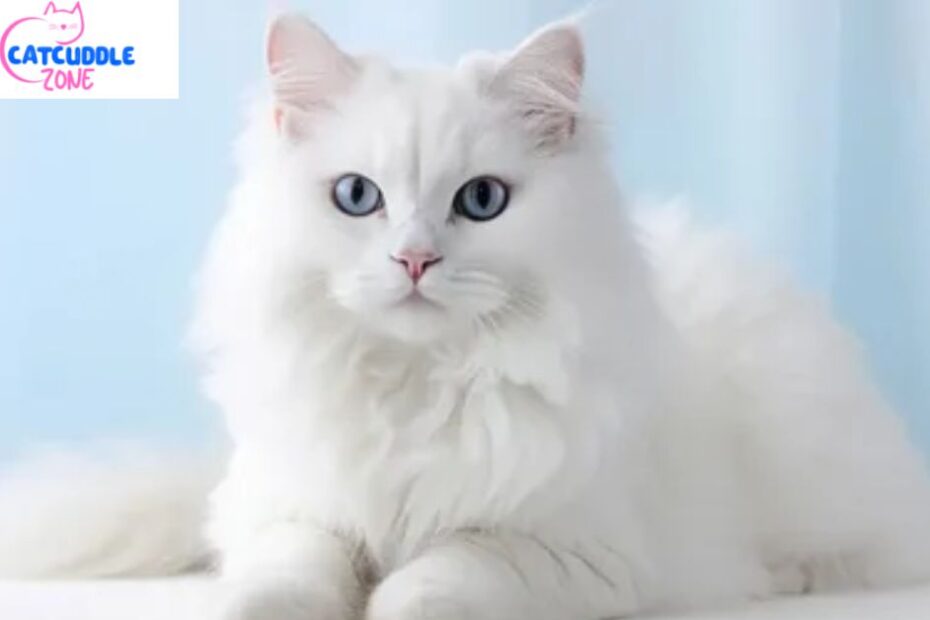The Russian White Cat is a rare gem among feline companions, admired for its snowy coat, graceful elegance, and affectionate nature. Developed from the iconic Russian Blue cat, this breed brings together intelligence, loyalty, and calmness in one stunning package. It’s perfect for those seeking a peaceful companion with a hint of mystery.
Known for being part of the laid-back cats and loyal cat breeds, the Russian White thrives in quiet homes and forms deep bonds with its people. Its gentle personality and low-maintenance care make it one of the best indoor cats and a favorite among family-friendly cats.
Physical Characteristics & Appearance
Their long white coat makes them appear regal on account of their short hair. Their development is muscular yet gentle, weighing in between 7-15 pounds as well as being 10 inches tall. Intelligent characteristics, like green-on-the-inside eyes and a wedge-shaped head, mimic characteristics within the Russian White vs Russian Blue comparison. Their smooth coat hardly ever matted, and the only shedding they did was minimal, which is the reason that they were mentioned among cat breeds with low shedding.
Adult Russian Whites show a refined elegance. Their leg length and tail proportions lend them an aristocratic posture. Their coat’s fine texture feels soft but dense. This contributes to a luxurious petting experience. Many owners marvel at the balance of poise and plushness in this gentle intelligent cat breed.
Russian White Cat Personality & Temperament
The Russian White cat personality resonates with a mix of serenity and loyalty. These felines bond tightly to their primary human yet welcome others with affection. They might seem shy at gatherings, but they love being near loved ones. Their demeanor places them among the top calm cat breeds and quiet cat breeds, perfect for people wanting a steady companion.
Though they feel deeply, they remain independent thinkers. You might find yourself following their lead during playtime or mealtime. This cat with dog-like behavior quality illustrates how they sometimes train their people. They’re not always eager for tricks or obedience, so training Russian White cats means gentle encouragement rather than commands.
Compatibility with Families and Other Pets
For families with older kids, the Russian White fits right in. They avoid loud chaos and prefer steady routines, making them ideal for homes seeking relaxed pet companionship. Their temperament of Russian White cats allows them to warm up to respectful children and adjust well to quiet family environments.
These felines generally thrive with other cats and calm dogs, thanks to their social yet discerning nature. Since they retain some hunting instincts, younger pets or small animals might invite a chase. However, with proper introductions, many homes enjoy cohesive multi-pet households featuring this affectionate cat breed.
Caring for a Russian White Cat
Understanding how to care for Russian White cats starts with nutrition. They thrive on high-protein, meat-focused food with balanced fats and minimal fillers. This supports their sleek physique and encourages a healthy weight. Their Russian White cat diet and nutrition ensures they stay agile and energized without gaining excess weight.
Cookie-cutter grooming won’t do here. Owners should brush their cats weekly to maintain coat health and help control shedding. More frequent brushing may be needed during seasonal coat changes. This follows best practices for grooming requirements for Russian White cats. Helping them stay fit also includes interactive toys and climbing posts. That supports their Russian White cat exercise needs well.

Health & Lifespan
Russian White cats enjoy robust health, living comfortably into their late teens. Still, they can face common feline issues. Among these are obesity, dental disease, and joint stress. Awareness of Russian White cat health issues and common diseases in Russian White cats can help you prevent them.
A gentle nightly teeth brushing routine supports dental care for cats and helps avoid tartar buildup. Annual wellness exams keep track of weight, dental health, and digestion patterns. Owners should stay alert for slight gait changes, as they can indicate arthritis. Proper early intervention helps them stay vibrant for years.
Male vs Female Russian White Cat – What to Expect?
Males often grow a bit larger and may be slightly more outgoing. Females tend to be petite and occasionally more reserved. Yet, gender differences rarely define their personalities. Both sexes enjoy subdued households and thrive on affection.
Choosing between male or female Russian White cats mostly affects size and maturity speed. A male may remain playful longer, while a female might mature sooner. Adoption advice leans on matching temperament to your lifestyle—personality often matters more than gender.
History & Origins of the Russian White Cat
The Origin of the Russian White cat begins in the 1860s with the Russian Blue cat in Russia. Fast forward to 1971, when Australian breeders crossed Russian Blues with white domestic cats. After four generations of careful pairing, they registered the breed officially. This experience underscores their strong Russian White cat breeding history.
The intentional selection emphasized traits like loyalty, calmness, and beauty. As they spread beyond Australia to the USA, breeders and enthusiasts embraced their balanced nature and gentle elegance. This makes them one of the most fascinating transcontinental cat stories.
Russian White Cat vs Similar Breeds
Comparisons often begin with the Russian White vs Russian Blue showdowns. Russian Whites share the Blue’s shape, intelligence, and demeanor, but sport a pristine white coat. Versus the Turkish Angora, they are shorter-haired and quieter, offering a calmer presence. Compared to the White British Shorthair, they feel lighter and move more fluidly.
A quick trait table highlights distinctions:
| Breed | Coat Length | Activity Level | Typical Weight |
| Russian White | Short | Moderate | 7–15 lbs |
| Russian Blue | Short | Lively | 8–15 lbs |
| Turkish Angora | Medium | Energetic | 6–12 lbs |
| British Shorthair (white) | Short | Relaxed | 9–17 lbs |
This makes them excellent cats for apartments and discreet companions.
Where to Buy or Adopt a Russian White Kitten
Reputable American breeders can be found through national feline associations. Expect the Russian White cat cost to range widely, reflecting rarity and breeder credibility. Asking pointed questions helps: inquire about parent breed health, lineage paperwork, and early socialization habits.
Adoption offers another route. Although shelters rarely feature Russian Whites, rescues occasionally do. Comparing buying versus adopting, rescue supports endless companionship without hefty costs. For Americans seeking a trustworthy companion, both paths offer benefits.
Fun & Lesser-Known Facts About Russian White Cats
Russian White cats are called “dog-like” because they follow their owners and greet them eagerly. These personality traits of Russian White cats add depth beyond a typical lap cat. They may not fetch, but they greet you at the door.
These cats rarely suffer from allergy issues compared to long-haired breeds, earning them the hypoallergenic cats. Sadly, they remain a rare cat breed, so seeing one in person feels special. Their serene presence makes them among the best indoor cats and a top choice for older people.
Summary
This Russian White Cat guide highlights the breed’s loyal intellect, affectionate nature, and quiet suitability. From low-maintenance grooming to understanding whether our Russian White cats are good with kids, this breed remains a calm, caring companion. Their modest shedding, longevity, and friendly temperament make them ideal for loving households.
(FAQ)
How rare are Russian White cats?
Russian White cats are extremely rare, especially outside Australia, where the breed originated. Finding one in the USA can be difficult due to limited breeders.
How much does a White Russian cat cost?
The Russian White cat cost typically ranges from $800 to $2,000 depending on lineage, breeder reputation, and location.
What is a White Russian cat?
A White Russian cat is a white-coated feline developed by breeding a Russian Blue cat with a white Siberian, retaining the Russian Blue’s calm and intelligent personality.
Is White Russian also a cat?
Yes, the White Russian is a cat breed known for its soft white coat, vivid green eyes, and gentle, affectionate nature.
Is a Russian Blue cat rare?
The Russian Blue cat is not as rare as the Russian White but is still considered uncommon and highly prized for its hypoallergenic qualities and serene personality.
